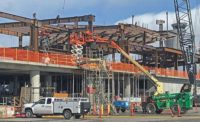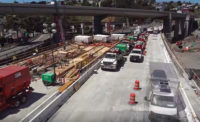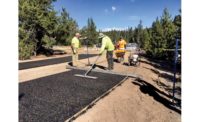Ten years ago, Geoff Neumayr decided he was tired of “doing design and construction by combat.” San Francisco International Airport had completed a master plan for the complex and the front of the airport facilities doing things the traditional way.
“It got done with a lot of struggles,” the chief development officer for SFO's design and construction division recalls. “After that program, there were things from the stakeholders’ perspective that they weren’t satisfied with. There were back of house problems. Being on time and budget was not good enough. We wanted to be exceptional, with exceptional project outcomes. That was a turning point.”

SFO’s $7.5B capital program is nearing the finish line with no claims or lawsuits.
Photo courtesy of SFO

Photo courtesy of SFO
The term “progressive design-build” (PDB) was not common at that point, but SFO started to adopt its basic principles. “We began to take seriously what partnering was all about,” Neumayr says. “I was inspired by the potential.” While he adds that he may not have envisioned that SFO would adopt PDB “to the scale that it could transform things the way it has, we could at least transform SFO into a special place to do special projects.”
The airport now is wrapping up a $7.5-billion capital program with no major claims or schedule overruns and is among the nation’s aviation leaders in sustainability.
A key component is the $2.6-billion Harvey Milk Terminal 1 Boarding Area B, a reconstruction of the 25-gate, 620,000-sq-ft concourse featuring open gate lounges, concessions, dining spaces and a museum exhibit. The sustainable design and construction practices along with environmentally friendly materials earned the project the world’s first LEED v.4 Platinum designation for an airport terminal.
The program included, among many other items:
- A $979-million modernization and upgrade of Terminal 3.
- A $150-million, six-story, 1.2-million-sq-ft parking garage at San Francisco International that was designed to be the most technologically advanced structure of its kind, featuring an automated parking guidance system that signals drivers about the availability of stalls, an access- and revenue-control system for reserved parking and a “find my car” function at the pay stations.
- A $172-million AirTrain extension that significantly enhanced connectivity. Carried out over 40 months using PDB, the project extended the existing electric people-mover system to a long-term parking garage, parking lots and ground transportation staging areas. New stations were provided at the garage and at the new Grand Hyatt hotel.
- A $78-million water-wastewater treatment plant.
- A $142-million air traffic control tower that is the first of its kind to employ a performance-based seismic design with vertical post-tensioning. It is also the tallest vertically post-tensioned structure in California.

SFO’s $7.5B capital program is nearing the finish line with no claims or lawsuits.
Photo courtesy of SFO
Collaborative Course
Wayne Campbell, senior design manager on the design-build team of Austin Commercial and Webcor that designed and built the $850-million boarding area portion of Terminal 1 and Boarding Area B, says, “We had to learn to work together, and SFO was instrumental in the learning adventure. It is very serious about the partnering program, which brings all facets of the teams together and really set up an environment where people felt free to voice concerns about the project and work through the problems.”
He adds: “One key to [SFO's] program was that [it] wants to know anytime there is an issue big or small and how to help solve it. SFO is always at the forefront of trying to come up with a solution that worked for all parties, not just itself or one person’s agenda.”
“We are pushing change ... [for] national and global climate ambitions.”
Erin Cooke, SFO Sustainability Director
Kristin Allen, SFO project manager for Terminal 1, says the team dubbed it “Terminal First.” “There were elements that were new to the airport,” she says. “So many new things—progressive design-build, the big co-location space for two design-build teams and a progressive sustainability program to round it all out. We were looking at a big vision for everyone.”
The Terminal 1 project kicked off with a six-month programming session with stakeholders, she says. “In the past, we would have done bridging documents, then bring in the design-build team. Now it was a blank slate, and we brought everyone in to envision the building together. At the end of programming, we asked, ‘how much can we afford?’ Having an open dialogue and transparency went a long way.”
SFO engaged 35 stakeholder groups as it pursued its capital plan. Teams worked with the basic floor plan, and “we ended up widening part of the building to enhance the concessions program,” Allen recalls. Rather than design the building and then plug a new baggage handling system into it, the baggage handling team participated in the design, she says.

Cooke runs SFO’s sustainability program.
Rosendin Electric provided special systems for multiple projects throughout the airport, including smart glass, CCTV, Wi-Fi, security and access control. “We worked with two different general contractors, and we had different architects and designers and engineers and all this stuff going in parallel through a design at the same time,” recalls Ron Clarkson, Rosendin national transit and special systems operations manager. “The airport demoed an old airplane hangar and made a massive collaboration room,” he says. “There were places where you could say, ‘let’s go talk about this while we play a game of cornhole or ping pong’ and work through this issue we have. We couldn’t avoid each other because we were all in the same space, and it forced us to talk and work through the issues—and it was an awesome undertaking.”
David Hiskey, vice president of aviation with Austin Commercial, praises the trust that SFO staff shows toward contractors. “One exceptional part of SFO’s project approach is how SFO motivates their program management team,” he says. “Often, program managers spend their time ‘watching the contractor.’ SFO makes it clear that they already trust their contractors. After a few adjustments, we had an excellent program management team. When the ‘one team’ devotes their energy moving the project forward rather than duplicating efforts checking on each other, the results are tremendous.”

Using modeling goes hand in hand with progressive design-build at SFO
Photo courtesy of SFO
As for aligning project scope and budget, “Austin Webcor provided detailed, itemized cost estimates early in design, which allowed SFO to make informed decisions on scope and funding for the project,” Hiskey adds. “Some scope items were held below the line where SFO could make decisions at the last responsible moment when procurement was underway and available funding could be accurately forecast. This can only happen if budget information is transparent and the team is working together to create the best project possible within the available budget.”
The project delivery process is aided by extensive use of 3D and 4D. “Virtual design and construction has become integral to the success of our capital program,” says Neumayr. “Building information modeling has become much more than a modeling tool to become the projects’ single source of truth regarding scope, cost quantities and even aspects of scheduling.”
He notes that by integrating individual Revit models into GIS, “we are able to create a digital twin of the entire airport portfolio of infrastructure, including building and underground utilities.”
Progressive design-build is a “natural fit” for BIM, Neumayr adds. “It is a single model shared by the entire project team and eventually turned over to the airport. This leads to more accurate digital information that can be utilized post-occupancy for many other business use cases.”
Clarkson says that working with SFO on a progressive design-build project “has been one of the most interesting progressions of construction that I have ever done. I’ve been in the business for 32 years and [working at] SFO has completely changed the way we do business now.”

Terminal 1, named for iconic LGBTQ activist Harvey Milk, is the world’s first airport terminal to achieve LEED v.4 Platinum.
Photo courtesy of SFO
LEED the Way
Sustainability was built into the process from the beginning. “SFO set aside a certain amount of money for sustainability, and we were only able to use the money for sustainability,” says Campbell. “This was the first time I had an owner who set aside a bucket of money and said, ‘you can’t touch it unless you can draw a direct correlation back to sustainability.’”
SFO’s sustainable planning, design and construction guidelines have required a minimum of LEED Gold for all new facilities since 2011 as well as referencing other standards such as WELL, Fitwel, LivingBuilding Challenge, Envision and ParkSmart.
The airport now has 15 LEED certified facilities, nine tenant LEED certified spaces, one Fitwel 2-star certified terminal building, one ParkSmart certified parking structure and one Zero Energy-certified airfield operations building. In 2016, SFO set the goal to achieve zero waste going to landfills and to become the world’s first zero-waste airport by 2030.
Carol Lurie, regional aviation director at VHB, which prepared sustainability reports for SFO in the 2000s, calls the airport a role model. “SFO’s ambitious commitment to achieving net-zero carbon by 2030 is bolstered by its being out front in bringing sustainable aviation fuel to the Pacific Northwest, developing a robust climate action strategy and implementing a net-zero waste plan,” she says. “Its social equity plan emphasizes governance, engagement and performance and embraces a broad perspective of sustainability.”
“We could transform SFO into a special place to do special projects.”
Geoff Neumayr, Chief Development Officer, SFO
In 2019, SFO launched its Zero Waste Concessions program with a waste reduction policy requiring all foodware to be reusable, compostable or made of recyclable plastic materials. New programs include personalized waste sorting training to concessions and reusable foodware in two food courts.
About 70% of SFO’s 21 million sq ft across 43 buildings use natural gas for domestic hot water and space conditioning. But the airport created an action plan to support future electrification projects that also is available as a resource for other public agencies, campuses and airports. SFO also created a digital tool, the Natural Gas Assets Manager, to collect equipment information from as-builts and asset management information along with a customized equipment data collection form. The airport's switch from natural gas to electricity will remove more than 53,986 metric tonls of carbon dioxide greenhouse gas emissions.

Neumayr has long championed prgresive design-build
“SFO has been on this journey to ‘zero’ for five years,” says Erin Cooke, SFO sustainability director. Working with industry groups such as Airports Council International and peers from other airports such as San Diego and Atlanta, “I connected with other airports so I could understand their road map and their pain points. We are leveraging this community and pushing change as it relates to national and global climate ambitions.”
SFO asked Gensler to conduct a carbon use intensity study for Terminal 1, which it also helped design with firms Woods Bagot, ED2 International, HKS, KYA and Kuth Ranieri. The study estimated the baseline 50-year operating and embodied carbon footprint at 593 lbs/CO2e/sq ft—about average for a U.S. airport of SFO’s size. The final set of recommendations, including new all-electric compatible systems, dynamic glazing, high-efficiency baggage handling, certified GHG-free supplied electricity and onsite renewables will result in a 50-year carbon use intensity of 124 lbs/CO2e/sq ft—a 79% reduction.
“This terminal operates at less energy than the one it replaced, which is crazy because it’s also six times the size,” says Ryan Fetters, principal atGensler. “It takes a lot of gusto for the owner to do something like that—to make a lot of very big decisions early on and taking advantage of everything you can throughout.”
The airport plans a 10-mile-long seawall project of steel sheetpiles and concrete to provide an 8-ft-high barrier against flooding and 100-year storm waves from San Francisco Bay—forecast to rise by as much as 3 ft by 2085. The project is estimated to cost $587 million, with construction to start by 2025. But SFO is also looking at how the project would affect surrounding communities, says Fetters. The airport, he says, thinks: “We could build a giant seawall around us and never have to worry about sea level rise. But we would flood the neighboring community if that happened. That’s not okay.”

Terminal 1, named for iconic San Francisco-based LGBTQ activist Harvey Milk, is the world’s first airport terminal to achieve LEED v.4 Platinum.
Photo courtesy of SFO
Looking Ahead
The current capital program, called Ascent, is 90% complete, says Neumayr. “We are thinking about the future now and how we might rethink our development over the next 10 years. We have crafted a tentative plan that we will finalize and seek approval for as we move forward.”
Judi Mosqueda, SFO director of project management, planning, design and construction, says the next airport development plan is under environmental review. “It looks at the next 15 years of capacity and expansion we may need on the airfield,” she says. “We expect we could grow to 71 million annual passengers maximum.” At peak prior to the pandemic, the airport handled 58 million annual passengers.
She says one of her staff’s goals is to “accommodate disabilities more fully. Of course we comply with ADA ... but there is room to grow.” That might include quiet rooms for autistic children, better restrooms and other features. “I’m also focused on passenger amenities and how to make airports more entertaining.”
“[SFO]...has completely changed the way we do business now.”
Ron Clarkson, Rosendin Transit and Special Systems Operations Manager
Whatever elements the new program will have, it will include continued stakeholder collaboration. Todd Temple, northern California operations manager for Hensel Phelps, says that while “all owners value stakeholder engagement and feedback at some level, SFO is one that I’ve seen take it the farthest—stakeholders are engaged in program conception all the way through acceptance and operation.”
He adds that SFO is open to teams trying out new technology, such as the robotic dog Spot that used autonomous, 360° image-capturing technology while remotely walking the Terminal 1 jobsite. “We used drywall-finishing robots. We used robot technology to do layout of walls. Sometimes they worked really well, others didn’t, Temple says. "But [SFO is] continuously looking for opportunities to allow the industry to innovate and improve as a whole.”
He adds: “All relationships have ups and downs, and we’ve had our share of disagreements. But we always recognize that we can solve any problem if we’re willing to sit down and talk about it and respect each other’s opinion. SFO is a large organization with a bureaucracy and opportunities to improve. I really appreciate the willingness to continue to look for opportunities to get better, because that makes it worth doing future projects.”
--With Greg Aragon and Jim Parsons






Post a comment to this article
Report Abusive Comment